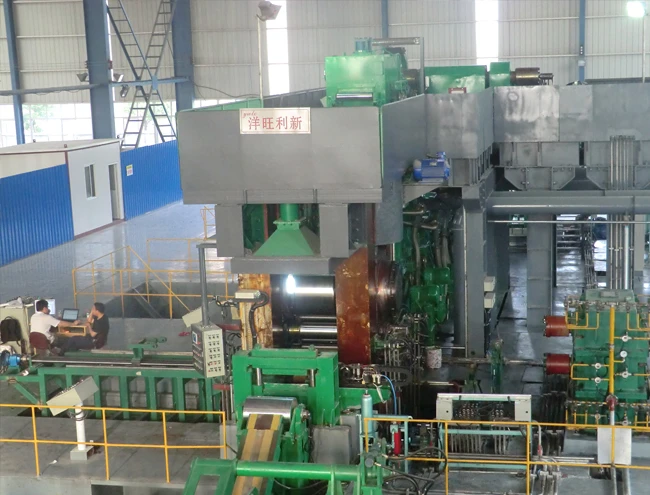
Cladding Rolling Mill-Beijing Yang Wang Li Xin Sci&Tech Co.,Ltd.|Cold Rolling Technology&Energy Efficient Production
Cladding Rolling Mill has emerged as a transformative solution in the metal processing industry, offering superior surface quality, energy efficiency, and cost-effective production. Developed by Beijing Yang Wang Li Xin Sci&Tech Co.,Ltd. (YWLX), this technology addresses critical challenges in traditional cladding methods, such as low yield, high energy consumption, and environmental concerns. This article explores the technical features, advantages, applications, and company background of YWLX's cladding rolling mill, supported by detailed specifications and industry insights.

Technical Features of the Cladding Rolling Mill
The cladding rolling mill leverages cold rolling technology to produce high-quality metal strips with minimal defects. Unlike traditional hot rolling methods, this process eliminates the need for acid pickling, resulting in a superior surface finish. The cold rolling process ensures that the metal strip is free from oxides, which are commonly adhered to the surface during hot rolling. This innovation not only enhances the aesthetic and functional properties of the final product but also reduces post-processing costs.
Another key technical advantage is the energy-efficient production process. By avoiding the re-heating of metal strips before rolling, the cladding rolling mill significantly reduces energy consumption. This aligns with global initiatives for environmental protection and sustainable manufacturing, as outlined by organizations like the National Institute of Standards and Technology (NIST). According to NIST, energy-efficient manufacturing processes are critical for reducing carbon footprints and promoting green technologies.

Advantages Over Traditional Methods
Traditional cladding techniques, such as hot roll bonding and explosive cladding, often face challenges like low yield, high investment, and environmental pollution. YWLX's cladding rolling mill addresses these issues through its simplified production process. The technology involves three main stages: surface treatment before rolling, bonding rolling, and annealing treatment. This streamlined approach achieves a yield rate of over 90%, significantly higher than conventional methods.
The low production cost and reduced investment make this technology particularly appealing to manufacturers seeking to optimize their operations. Additionally, the ability to bond bimetallic or tri-metallic materials in a single production line enhances versatility, allowing for the creation of complex metal composites tailored to specific industrial needs.
Applications in Key Industries
The cladding rolling mill is widely applicable across industries such as electronics, chemicals, automotive, and construction. In the electronics sector, the technology is used to produce copper-steel and aluminum-steel strips for heat dissipation and electrical conductivity. The automotive industry benefits from lightweight, corrosion-resistant cladding materials for components like exhaust systems and body panels. In the chemical industry, stainless steel-aluminum cladding provides durability and resistance to harsh environments.
According to a 2023 report by NIST, the demand for advanced metal composites is driven by the need for materials that combine the properties of different metals. YWLX's technology meets this demand by offering customizable solutions that balance performance, cost, and sustainability.
Company Background: YWLX's Innovation in Metal Processing
Beijing Yang Wang Li Xin Sci&Tech Co.,Ltd. (YWLX) is a leader in developing cold rolling cladding technology and complete equipment. The company has independently innovated processes for bonding various metal combinations, including copper-steel, aluminum-steel, copper-aluminum, aluminum-stainless steel, and stainless steel-steel strips. These technologies are now in practical production, with the ability to manufacture cladding coils up to 1000mm in width and as thin as 0.2mm.
YWLX's commitment to R&D and technological advancement is evident in its ability to produce high-quality, multi-layered metal composites. The company's expertise in roll bonding cladding has positioned it as a trusted partner for industries requiring precision and reliability in metal processing.
Product Specifications Table
| Parameter | Specification |
|---|---|
| Rolling Process | Cold Rolling |
| Surface Quality | Free from oxides, no acid pickling required |
| Energy Efficiency | Eliminates re-heating and acid treatment |
| Yield Rate | Over 90% |
| Production Process | Three stages: surface treatment, bonding rolling, annealing |
| Material Compatibility | Copper-steel, aluminum-steel, copper-aluminum, aluminum-stainless steel, stainless steel-steel |
| Maximum Width | 1000mm |
| Minimum Thickness | 0.2mm |
Industry Impact and Future Prospects
The adoption of YWLX's cladding rolling mill is reshaping the metal processing landscape. By reducing environmental impact and production costs, the technology supports the global shift toward sustainable manufacturing. As industries increasingly prioritize eco-friendly practices, solutions like this are expected to gain traction. For instance, the NIST has emphasized the importance of energy-efficient technologies in achieving long-term environmental goals.
Looking ahead, YWLX's continued investment in R&D and expansion of its product portfolio will likely drive further innovation. The company's ability to adapt to evolving market demands positions it as a key player in the future of metal composites.
Conclusion
YWLX's Cladding Rolling Mill represents a significant advancement in metal processing technology. With its focus on energy efficiency, surface quality, and versatile applications, this solution addresses critical challenges in traditional methods. As industries seek sustainable and cost-effective alternatives, YWLX's innovation sets a new standard for roll bonding cladding and cold rolling technology. For more information, visit the company website or explore the product page.
References
National Institute of Standards and Technology (NIST). (2023). Energy Efficiency in Manufacturing Processes. Retrieved from https://www.nist.gov.
-
YWLX’s 1450mm Six-Hi Reversing Mill Goes Live in BangladeshNewsNov.24,2025
-
Adjusting Roll Gap in 6Hi Reversing Cold Rolling Mill for Thin StripNewsNov.13,2025
-
Quality Control Standards for Automatic Gauge Control in Strip RollingNewsNov.13,2025
-
Effect of Skin Pass Rolling on Metal DuctilityNewsNov.13,2025
-
Key Components of a Modern TempermillNewsNov.13,2025
-
Common Wear Patterns of Work Roll in Tandem Cold Mill OperationsNewsNov.13,2025
-
Revolutionary Skin Pass Rolling Technology for Enhanced Steel QualityNewsNov.04,2025










